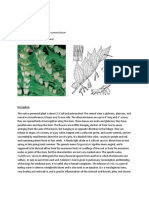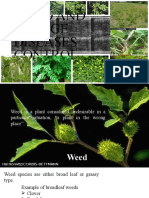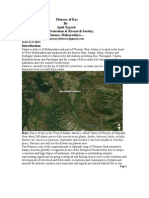Rika
Rika
Uploaded by
Sergiu StrungaruCopyright:
Available Formats
Rika
Rika
Uploaded by
Sergiu StrungaruOriginal Title
Copyright
Available Formats
Share this document
Did you find this document useful?
Is this content inappropriate?
Copyright:
Available Formats
Rika
Rika
Uploaded by
Sergiu StrungaruCopyright:
Available Formats
Common hazel (alun) A hazelnut is the nut of the hazel and is also known as a cob nut or filbert nut
according to species. A cob is roughly spherical to oval, about 1525 mm long and 1015 mm in diameter, with an outer fibrous husk surrounding a smooth shell. A filbert is more elongated, being about twice as long as it is round. The nut falls out of the husk when ripe, about seven to eight months after pollination. The kernel of the seed is edible and used raw or roasted, or ground into a paste. Hazelnuts are also used for livestock feed, as are chestnuts and acorns. The seed has a thin dark brown skin, which is sometimes removed before cooking.
Cornflower (albastrele) Cornflower is a small annual flowering plant in the family Asteraceae, native to Europe. "Cornflower" is also erroneously used for chicory, and more correctly for a few other Centaurea species; to distinguish C. cyanus from these it is sometimes called Common Cornflower. It may also be referred to as basketflower, though the term properly refers to the Plectocephalus group of Centaurea, which is probably a distinct genus. It is an annual plant growing to 16-35 inches tall, with grey-green branched stems. The leaves are lanceolate, 14 cm long. The flowers are most commonly an intense blue colour, produced in flowerheads (capitula) 1.53 cm diameter, with a ring of a few large, spreading ray florets surrounding a central cluster of disc florets. The blue pigment is protocyanin, which in roses is red.
Sea Buckthorn (ctin) The sea-buckthorns (Hippophae L.) are deciduous shrubs in the genus Hippophae, family Elaeagnaceae. The name seabuckthorn is hyphenated here to avoid confusion with the buckthorns (Rhamnus, family Rhamnaceae). It is also referred to as sandthorn, sallowthornor seaberry. The sea-buckthorn (Hippophae rhamnoides) is by far the most widespread of the species in the genus, with the ranges of its eight subspecies extending from the Atlantic coasts of Europe right across to northwestern China. In western Europe, it is largely confined to sea coasts where salt spray off the sea prevents other larger plants from out-competing it, but in central Asia it is more widespread in dry semidesert sites where other plants cannot survive the dry conditions. In central Europe and Asia it also occurs as a subalpine shrub above tree line in mountains, and other sunny areas such as river banks. They are tolerant of salt in the air and soil, but demand full sunlight for good growth and do not tolerate shady conditions near larger trees. They typically grow in dry, sandy areas. Black currant (coacz) Blackcurrant, Ribes nigrum, (Phalsa or Falsa) (Urdu: ) is a species of Ribes berry native to central and northern Europe and northern Asia, and is a perennial. It is a small shrub, growing to 12 m tall. The leaves are alternate, simple, 35 cm long and broad, and palmately lobed with five lobes, with a serrated margin. The flowers are 4 6 mm diameter, with five reddish-green to brownish petals; they are produced in racemes 5 10 cm long. When not in fruit, the plant looks similar to the redcurrant shrub, distinguished by a strong fragrance from leaves and stems. The fruit is an edible berry 1 cm diameter, very dark purple in colour, almost black, with a glossy skin and a persistent calyx at the apex, and containing several seeds dense in nutrients. An established bush can produce up to 5 kilograms of berries during summer.
Chamomile (romania) Chamomile or camomile is a common name for several daisy-like plants of the family Asteraceae. These plants are best known for their ability to be made into an infusion which is commonly used to help with sleep and is often served with either honey or lemon. Because chamomile can cause uterine contractions which can lead to miscarriage, the U.S. National Institutes for Health says that pregnant and nursing mothers should not consume chamomile. Chrysin, a flavonoid found in chamomile, has been shown to be anxiolytic in rodents,and is believed to be at least partially responsible for chamomile's reputation as a sleep aid. It is known to reduce stress.
You might also like
- How To Make Coffee PDFDocument21 pagesHow To Make Coffee PDFEdgarGarcia100% (1)
- Tropical Plants Commonly Found in The PhilippinesDocument20 pagesTropical Plants Commonly Found in The PhilippinesjoytomboNo ratings yet
- Forage LegumesDocument6 pagesForage LegumesHannah BigsatNo ratings yet
- Scientific Name: Agapanthus Praecox Willd Common Name: Blue Lily or African Lily DescriptionDocument11 pagesScientific Name: Agapanthus Praecox Willd Common Name: Blue Lily or African Lily DescriptionJey VlackNo ratings yet
- Quad 6 FinalDocument9 pagesQuad 6 FinalanlouwiseNo ratings yet
- Amaranthaceae and AmaryllidaceaeDocument2 pagesAmaranthaceae and AmaryllidaceaeZaivie VillanobosNo ratings yet
- RG 07-08 RWDocument3 pagesRG 07-08 RWJia ManceraNo ratings yet
- Scientific Name FinDocument10 pagesScientific Name FinJey VlackNo ratings yet
- Scientific All NameDocument5 pagesScientific All Nameleo AñascoNo ratings yet
- Rare Flowers MineDocument89 pagesRare Flowers MineStephanie Louisse Gallega HisoleNo ratings yet
- Final Demo SlidesDocument25 pagesFinal Demo SlidesJullemar GuladaNo ratings yet
- African Daisy Orange: Dimorpotheca Greek Dis (Twice) + Morphe (Shape) + Theka (A Fruit)Document11 pagesAfrican Daisy Orange: Dimorpotheca Greek Dis (Twice) + Morphe (Shape) + Theka (A Fruit)Vikas AroraNo ratings yet
- Exercise No. 24Document30 pagesExercise No. 24Francis Jay MerencilloNo ratings yet
- Keanekaragaman Hayati: 1. Amaranthus SPDocument7 pagesKeanekaragaman Hayati: 1. Amaranthus SPMalLaNo ratings yet
- Plant PressDocument24 pagesPlant PressRexan Jay VallejosNo ratings yet
- List of PlantsDocument4 pagesList of PlantsKim KwonNo ratings yet
- Sweetpotato Germplasm Management - Ipomoea Batatas - Training ManualDocument218 pagesSweetpotato Germplasm Management - Ipomoea Batatas - Training ManualDianis ParedesNo ratings yet
- Classification of Botanical CropsDocument16 pagesClassification of Botanical CropsJhanno Belleña Edig DapitanonNo ratings yet
- Endangered Plants in The PhilippinesDocument35 pagesEndangered Plants in The PhilippinesNigel Evardone Cruise45% (11)
- Chelsea ArcherDocument2 pagesChelsea Archerapi-24572051No ratings yet
- Tropical Plant GuideDocument15 pagesTropical Plant GuideDerrick Yson (Mangga Han)100% (1)
- Lagundi (Vitex-WPS OfficeDocument11 pagesLagundi (Vitex-WPS OfficeJay-ar TV100% (2)
- Weed and Forage Diseases ControlDocument26 pagesWeed and Forage Diseases ControlJonathan Aycardo FestinNo ratings yet
- HeliconiaDocument4 pagesHeliconiaGayathri AgNo ratings yet
- An Encyclopedia of Philippine TreesDocument162 pagesAn Encyclopedia of Philippine TreesDerrick Yson (Mangga Han)No ratings yet
- Tugas Bahasa InggrisDocument5 pagesTugas Bahasa InggrisSiti Van HoustanNo ratings yet
- Botanica. Name Scientific NamaDocument5 pagesBotanica. Name Scientific Namabiosekuriti nsNo ratings yet
- Biology Report G6Document24 pagesBiology Report G6Allen JangcaNo ratings yet
- SubbuDocument10 pagesSubbuSagar SbNo ratings yet
- 10 Medicinal Plants and Their UsesDocument6 pages10 Medicinal Plants and Their UsesIvan ObiasNo ratings yet
- Mussaenda Quenn Sirkit ArticleDocument10 pagesMussaenda Quenn Sirkit ArticleChris MaceyNo ratings yet
- Biology Investigatory ProjectDocument20 pagesBiology Investigatory ProjectSnehaNo ratings yet
- GrapesDocument13 pagesGrapesasddulatNo ratings yet
- 18bbo53c U4Document27 pages18bbo53c U4FranNo ratings yet
- RanunculaceaeDocument61 pagesRanunculaceaedubeyshruti519No ratings yet
- Plants of Bahay KuboDocument17 pagesPlants of Bahay KuboGagan Gora0% (1)
- AMARANTHACEA LatestDocument5 pagesAMARANTHACEA Latestladimeji07No ratings yet
- FlowersDocument4 pagesFlowersViji ThulasiramanNo ratings yet
- Θ Η Ε -1 - (Α-ΑΚΩΜΑΖΩΝ)Document8 pagesΘ Η Ε -1 - (Α-ΑΚΩΜΑΖΩΝ)Elena100% (1)
- evs ppt-1 new (1)Document31 pagesevs ppt-1 new (1)kcv1503fNo ratings yet
- Greenhouse Plant ResearchDocument17 pagesGreenhouse Plant ResearchGustavo GomezNo ratings yet
- AnthuriumDocument5 pagesAnthuriumYuni NurcahyaniNo ratings yet
- Mimosa PudicaDocument4 pagesMimosa PudicaIna Guinar100% (1)
- Assingment-3 Study of Plants: Subject-Landscape Design and Ecological Architecture Course Code - 8ar173Document30 pagesAssingment-3 Study of Plants: Subject-Landscape Design and Ecological Architecture Course Code - 8ar173CHANDAN KUMARNo ratings yet
- Royal Palm/Bottle Palm: Arecaceae Arecoideae RoystoneaeDocument6 pagesRoyal Palm/Bottle Palm: Arecaceae Arecoideae RoystoneaeDivyaa SaxenaNo ratings yet
- Plants For Major Highways and Major Roads: Landscape ArchitectureDocument41 pagesPlants For Major Highways and Major Roads: Landscape ArchitectureCapao PadillaNo ratings yet
- Flowers of KasDocument9 pagesFlowers of KasAmit SayyedNo ratings yet
- 3 Endangered Plant SpeciesDocument7 pages3 Endangered Plant SpeciesBharat SinghNo ratings yet
- Barangay Roads Plants: Buenafe - Cabrera.Capuyan - Capacillo.ChoDocument16 pagesBarangay Roads Plants: Buenafe - Cabrera.Capuyan - Capacillo.ChoCapao PadillaNo ratings yet
- World of VegetablesDocument100 pagesWorld of VegetablesSundara VeerrajuNo ratings yet
- OrnamentalDocument5 pagesOrnamentalJohn Michael BautistaNo ratings yet
- Botanical Description of PlantsDocument9 pagesBotanical Description of PlantsSagar SbNo ratings yet
- AsteraceaeDocument21 pagesAsteraceaenivethamycologyNo ratings yet
- Acacia (A-Ka'sha) .: Wild Types of FlowersDocument12 pagesAcacia (A-Ka'sha) .: Wild Types of FlowersGanesh KaleNo ratings yet
- UmmeLaila (18arid2374) Practical Notebook HORT - 603Document15 pagesUmmeLaila (18arid2374) Practical Notebook HORT - 603UmmelailaNo ratings yet
- Taxonomy RankingDocument4 pagesTaxonomy Rankingangelnicoleconcha86No ratings yet
- FloraDocument37 pagesFloraVinie CastroNo ratings yet
- Plantae Tracheobionta Spermatophyta Magnoliophyta Liliopsida Zingiberidae Zingiberales Costaceae Costus L. Costus Speciosus (J. Koenig) SMDocument8 pagesPlantae Tracheobionta Spermatophyta Magnoliophyta Liliopsida Zingiberidae Zingiberales Costaceae Costus L. Costus Speciosus (J. Koenig) SMSeìssarìa EssaNo ratings yet
- Assigmnt AgrDocument35 pagesAssigmnt AgrLegasi DuanityNo ratings yet
- Family MusaceaeDocument13 pagesFamily Musaceaenasrin4329.nkNo ratings yet
- Lteif Anthony E02e - PlantsDocument2 pagesLteif Anthony E02e - PlantsSaiid GhimrawiNo ratings yet
- Myanmar Aquaculture and Inland FisheriesDocument68 pagesMyanmar Aquaculture and Inland Fisherieshninshwesin61No ratings yet
- Cut Flower Farm Gladiolus Marigold Statice and Chrysanthemum PDFDocument20 pagesCut Flower Farm Gladiolus Marigold Statice and Chrysanthemum PDFMian Adi ChaudhryNo ratings yet
- Ram Prasad Mainali, Toya Nath Joshi, Sagar Kafle, Yagya Prasad Giri, Santosh MarahattaDocument2 pagesRam Prasad Mainali, Toya Nath Joshi, Sagar Kafle, Yagya Prasad Giri, Santosh MarahattaToyanath JoshiNo ratings yet
- NonifinalDocument2 pagesNonifinalMichael GiaNo ratings yet
- Acclimatization of Micropropagated Silvan Blackberry PDFDocument107 pagesAcclimatization of Micropropagated Silvan Blackberry PDFBrij Mohan Singh100% (1)
- Development of Fish Pond Monitoring and Control System: M. J. Atta and J. TsadoDocument1 pageDevelopment of Fish Pond Monitoring and Control System: M. J. Atta and J. TsadoBayeNo ratings yet
- ZimbanjeX Pitch Incl Trial AskDocument14 pagesZimbanjeX Pitch Incl Trial AskTaf GongNo ratings yet
- Bio 1113 Seeds Worksheet 1 2016Document2 pagesBio 1113 Seeds Worksheet 1 2016Anonymous 11872REqq0% (1)
- Project Report On Water PollutionDocument31 pagesProject Report On Water Pollutionavakash patelNo ratings yet
- Nepal Gajendra BOHRA 2005Document24 pagesNepal Gajendra BOHRA 2005gfc08No ratings yet
- Achieving Water Security - 2013Document225 pagesAchieving Water Security - 2013António Oliveira100% (1)
- Wonham&Wasson.2023."The Spear of Quartz": A Zoopoetic and Ecopoetic Analysis of Neruda's "Mollusca Gongorina".ISLEDocument26 pagesWonham&Wasson.2023."The Spear of Quartz": A Zoopoetic and Ecopoetic Analysis of Neruda's "Mollusca Gongorina".ISLEMWNo ratings yet
- Thesis Jayson 1Document24 pagesThesis Jayson 1sorpekmangulabnanNo ratings yet
- 11th Plan-HorticultureDocument484 pages11th Plan-Horticulturebs_nhbNo ratings yet
- Milma Diary FinalDocument66 pagesMilma Diary FinalClick Pick100% (2)
- Presentation Malaysia's EconomyDocument22 pagesPresentation Malaysia's EconomyAnonymous 43pBkN3iNo ratings yet
- Road To IELTS Listening - 6 Tests MergedDocument58 pagesRoad To IELTS Listening - 6 Tests MergedNguyễn Minh HuyềnNo ratings yet
- Chapter 1.Document7 pagesChapter 1.Vnxe AbrazadoNo ratings yet
- The Benny StoryDocument2 pagesThe Benny Story80096No ratings yet
- Rainwater Harvesting: Vivekanand Education Society PolytechnicDocument26 pagesRainwater Harvesting: Vivekanand Education Society Polytechnicsidhhart kunkololNo ratings yet
- Bombas KMPDocument42 pagesBombas KMPReagrinca Ventas83% (6)
- As 2726.1-2004 Chainsaws - Safety Requirements Chainsaws For General UseDocument7 pagesAs 2726.1-2004 Chainsaws - Safety Requirements Chainsaws For General UseSAI Global - APACNo ratings yet
- Birding in SumatraDocument60 pagesBirding in SumatraT-Jack RimbawanNo ratings yet
- Timber Treatment Alternatives Organicnz Jul Aug 08Document4 pagesTimber Treatment Alternatives Organicnz Jul Aug 08Tina MacnicolNo ratings yet
- SLG-BIOLOGY 2-LG1.4-Applications of DNA ScienceDocument5 pagesSLG-BIOLOGY 2-LG1.4-Applications of DNA ScienceClaudette BisnarNo ratings yet
- Key Employment GeneratorsDocument71 pagesKey Employment GeneratorsAngel Amor Galea100% (1)
- Ben Harden Method of Raising Honey Bee Queen CellsDocument4 pagesBen Harden Method of Raising Honey Bee Queen CellsOdprirodeNo ratings yet
























































































